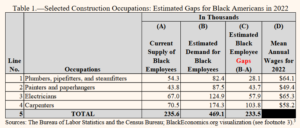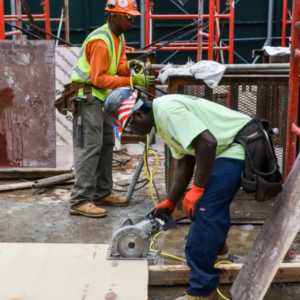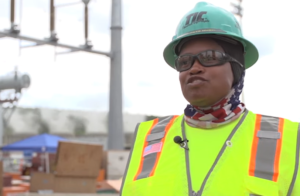Photos: YouTube Screenshots
There is considerable and widely acknowledged evidence that a college education can provide a favorable return on investment—especially for those who pursue certain scholarly fields.

Also, there is evidence that certain Black Americans perform below academic standards at elementary and secondary school levels. These students, in large measure, would find it difficult to perform at the post-secondary level without considerable remediation. Therefore, many of these Black Americans do not attend college because they do not qualifying—saying nothing about college’s often prohibitive cost. In 2021, over 40 percent of Black American high school completers did not attend a post-secondary institution immediately thereafter.[1]
At the same time, certain Black Americans perform successfully at the elementary and secondary levels, go on to college, confront exorbitant costs, borrow to survive the ordeal, and conclude their education with sizeable debt overhang.
This essay asks whether Black Americans can afford college? The question is posed in the context of a multi-generational plan that spans more than 100 years. It turns out that without a “plan”—or at least not a plan fashioned by Black Americans—many of us attended college, survived the ordeal, have ensured that our offspring perform the same ritual, and are now seeing third, fourth, or more generations repeat this process. For those who fit this paradigm and where financial resources are sufficient to provide a college education without undue burden, then it may be logical to continue this process and gain the related economic benefits.
For those who have experienced college—or an attempt at college—as a nightmare, then a Black American plan should offer a different route to successful living.
Therefore, let us consider a well-known alternative, and then consider the likely outcomes. This consideration is undertaken in view of the increasingly well-known Long-Term Strategic Plan for Black America (LTSP). Specifically, consider four construction-related trade occupations (plumbing, electrician, carpenters, and painters) that can not only provide favorable careers, but that can also facilitate fulfillment of objectives outlined in the LTSP.


Table 1 shows that if we adopt estimates of the national population per employee in the four occupations and compute similar population per employee requirements for Black America’s population (column B), then sizeable gaps appear because Black Americans are underrepresented significantly in each of the occupations (column A). The total gap (line 5, column C) is estimated at 233.5 thousand for 2022.
In other words, if Black American employees in each of these occupations relative to the Black population was made equal to the number of all employees in these occupations relative to the national population, then an additional 233.5 Black employees would be required in these occupations. If we could wave a wand and hire 233.5 additional Black workers, then the 2022 number of Black unemployed persons would decline by nearly 20 percent.[2]

Before undertaking further analysis of Table 1 statistics, a brief reminder is in order. The LTSP calls for Black Americans to seek to achieve greater independence, self-reliance, self-determination, and liberty in the US. It requires that we withdraw, to the extent possible immediately and increasingly over time, from the broader nation and produce for ourselves and consume what we produce.
We are, of course, a “Nation within a Nation.” That is, Black Americans should create an economy that meets our needs and reduces substantially our dependence on other races and ethnicities. History informs us that this is our best alternative for the future.
Returning to Table 1, it shows that three of the occupations reflect wages that are more than twice the poverty level and are about 70 percent of Black and nearly 50 percent of national mean household income.[4] Notably, there are numerous occupations requiring college degrees that reflect annual average wages lower than those cited in Table 1.
The fact is that wand waving is fantasy. Consequently, Black Americans who choose to pursue careers in these occupations must obtain the requisite training. The good news is that the cost of such training is a fraction (about 30 percent or less) of that associated with a bachelor’s degree.[5]

A review of history will reveal that Black Americans comprised the primary source of skilled craft construction labor well into the nation’s history. Our contributions to the construction trades are widespread and deep. However, we were purposely and systematically pushed from this work by hook and crook—through legal and racist discriminatory means. Now it is time for Black Americans to consider regaining our command of these skilled crafts to facilitate our efforts to achieve independence, self-reliance, self-determination, and liberty.
As outlined in the LTSP, Economic Affairs, Education, and Housing and Community Amenities sectors’ “Responsible Parties” should seek to motivate our youth, who are best fit for these skilled crafts, to pursue these occupations. Potentially, they can grow in these occupations and generate sufficient wealth to ensure that their future generations can afford college. Otherwise, as was done in
the past, their skills, occupations, and enterprises can be passed on to their off-spring.
The bottom line is that if we want to build and own the residential and nonresidential buildings and infrastructure in our areas of influence, and to stop the bleeding of financial resources for this work that feeds non-Black vampires who suck our communities dry, then we must relearn to perform this essential work. We should reverse our dependence and become independent producers of our requirements.
If we pursue this strategy, then Black youth should opt into these occupations. As importantly, Black Americans already operating in these occupations should ensure that enterprises are available to absorb these youth. Most importantly, Black Americans should not fail to support these enterprises.


The idea is that Black America can begin to operationalize the proverbial “killing multiple birds with one stone.” We can create opportunities for our youth; slow and ultimately halt their destruction in the streets by ensuring that they are occupied constructively; create new employer businesses; produce goods for ourselves that we own; increase our independence; and starve out blood-sucking outsiders. In the process we can save a tremendous amount of financial resources by realizing that we do not have to go to college to pursue a bachelor’s degree to enjoy a sound, productive, and favorable quality of life.

Dr. Brooks Robinson is the flounder of the BlackEconomics.org website
References:
[1] National Center of Education Statistics (2021), “Immediate College Enrollment Rate;” https://nces.ed.gov/programs/coe/pdf/2023/cpa_508.pdf (Ret. 080323).
[2] For 2022, 1.3 million Black persons 16 years of age and older were unemployed on average. See the following BLS Current Population Survey “Table 24. Unemployed persons by marital status, race, Hispanic or Latino ethnicity, age, and sex;” https://www.bls.gov/cps/cpsaat24.pdf (Ret. 080223).
[3] The statistics in columns A and B are derived from Bureau of Labor Statistics (BLS), Current Population Survey Table 11. Employed persons by detailed occupation, sex, race, and Hispanic or Latino ethnicity (https://www.bls.gov/cps/cpsaat11.htm) and Census Bureau data on the national and Black American populations in 2022 (https://www.census.gov/quickfacts/fact/table/US/PS
T045221). Wage statistics that appear in column D are from BLS’s “Occupational Employment and Wage Statistics” (https://www.bls.gov/oes/tables.htm) (Ret. 080223).
[4] For 2022, the US Department of Health and Human Services reports that the poverty level for a family of four residing in the 48 contiguous states was $27,750; https://aspe.hhs.gov/sites/default/files/documents/4b515876c4674466423975826ac57583/Guidelines-2022.pdf. For 2021, the Census Bureau reports that mean household income for Blacks was $71,528 and was $102,316 for the nation; “Table H-5. Race and Hispanic Origin of Householder–Households by Median and Mean Income: 1967 to 2021;” https://www.census.gov/data/tables/time-series/demo/income poverty/historical-income-households.html (Ret. 080223).
[5] For example, for the State of Wisconsin university system, in-state tuition (only) for a bachelor’s degree is about $30 thousand; https://uwhelp.wisconsin.edu/pay-for-college/annual-tuition/ (Ret. 080223). On the other hand, the cost of training (courses) to achieve apprentice status for construction occupations is about $10 thousand. We obtained the latter information from Association
Building Contractors (nonunion; 800-829-9926) and from Madison Plumbing Joint Apprenticeship Contractors (union and nonunion; 608-288-1414) by telephone on August 2, 2023









